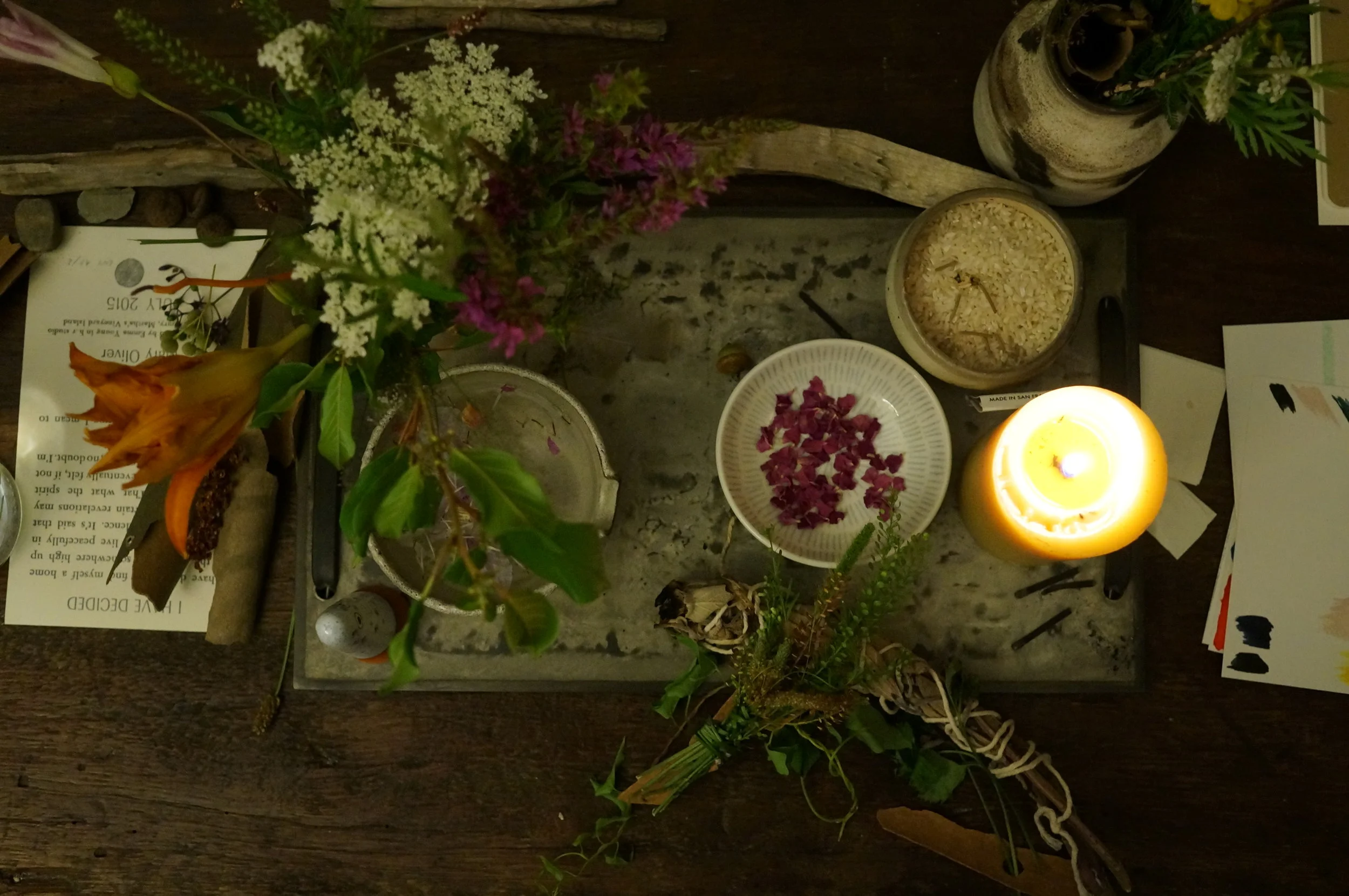Making Space for Stillness
Making Space for Stillness
Words by Diana Limbach Lempel
Photographs by Meral Agish
I have a vivid smell-memory from my childhood: it’s a smoky, earthy smell, filling my grandmother’s house in between garlic-and-olive oil dinners. When I was young, she had a Zen center in her basement. I remember seeing her, sitting still and silent, in front of an old oak dresser topped with a fossil and a brass candle holder, a small arrangement of flowers in a bud vase, a thimbleful of water in a small red lacquer vessel, and the snake of incense smoke, lazing past her closed eyes and filling the rest of the house with the smell of quiet.
About a year ago, I realized that I was making altars like hers all over my house. It was an instinct. One that I’m sure comes from those years hovering on the threshold of the Zendo, with its quiet and purposeful, almost austere beauty. I collected rocks and driftwood and flowers as I moved through the world, and they would come to rest – often in jumbles – on mantels, dressers, kitchen counters, and in the middle of my dining room table. I thought of them more as landing places for objects, and not a particular kind of space in my house.
“I collected rocks and driftwood and flowers as I moved through the world, and they would come to rest – often in jumbles – on mantels, dressers, kitchen counters, and in the middle of my dining room table.”
But when I realized what I was doing, I decided to give this practice more intention. I asked my grandmother what the traditional elements of her altar are, and even though I myself am not Buddhist, I began to incorporate them into my arrangements. And when the little collections-of-stuff-I’d-picked-up became altars, it changed the way I thought about my home: both the building where I live, and the landscape it’s part of. I pay attention to the full moon cycle so that I can let new rocks receive its glow. I scan the sidewalk for small wildflowers that I can bundle up and put in a little vase. I have a new purpose for the small ceramic vessels that I pick up at festivals and open studios. I stop and check to make sure the water hasn’t run out in my little cups around the house. I rotate them seasonally, as new objects take on new meaning in my life, like a rock from a recent beach vacation, a poem or photograph, or the collection of delicate eggshells that I put out every spring.
An altar is about making space, but also making time in my life for this kind of presence. I’m not a religious person. I don’t love the idea of “believing in” things. What I love about the altar, both the fact of it and the symbolism within it, is how it makes me aware of the time of year, how it catches my attention with specific memories, and how it makes me feel like I’m incorporating the rhythms and senses of the place where I live into my home. It’s a New England altar, with birch and slate and granite, wild goldenrod in the summer, apples and maple leaves in the fall. In the spring I snip budding plum branches and swap heavy winter ceramics for light, hopeful-for-warmer-weather ones. In winter I forage milkweed pods and double the number of candles. The altar is both a physical space, and a mental space, for reflection and awareness. And when I light the candle, it reminds me to be present, and pay attention, and take the time I need to appreciate my home.
“It’s a New England altar, with birch and slate and granite, wild goldenrod in the summer, apples and maple leaves in the fall. In the spring I snip budding plum branches and swap heavy winter ceramics for light, hopeful-for-warmer-weather ones. In winter I forage milkweed pods and double the number of candles. The altar is both a physical space, and a mental space, for reflection and awareness. ”
This summer I hosted a retreat for a group of friends at my house. We put an altar at the center of our reflections. At the end of the weekend, they told me that they’d never thought about making an altar before, and that it felt like a profound move to them. Only a few simple ideas and a small collection of objects, designed to be the heart of the home and the center of our conversations. We began to talk about how they could each incorporate the idea into their own lives, especially in apartments where space is such a premium, as a way to remind themselves of the intentions they have for reflection, stillness and meaning in their own lives. Windowsills and small platforms on top of radiators are good options; there are some small spots in my house where I use a little plate or tray to set the altar apart from the rest of a tabletop.
The Key Elements of my Altar
1. A vessel filled with water, to symbolize clarity in your mind
2. A candle, for the light of wisdom
3. Incense, or something that smells, to engage the senses and bring awareness
4. Fresh flowers, a reminder that life is fleeting
5. A rock, to ground me to the earth
6. A symbol of the greater community, and the world that I’m a part of
7. Sometimes, I put a photo, or a poem, on the altar too – to capture something I’m thinking a lot about, or want to repeat to myself. I try to find poems that seem to capture the New England landscape, and the season.
♢♢♢
Diana’s Favorites:
The “Ghosts” on my altars are made by Studio Arhoj, from Denmark, and I buy them from More & Co. in Portland, ME. I give one to every friend and family member as a housewarming gift, because they seem to me like a “minimalist” version of two traditional kinds of talismans. One is the jizo, a Buddhist protector of crossroads, children, and journeys. The second is the nisse, or tomte, a Scandinavian gnome-like protector of the traditional farmstead. I like the idea that these little friends are watching over the kitchens and backyards of my extended family around the country.
Most of the pottery in my home comes from New England potters. A favorite of mine is Ariela Kuh (ANK Ceramics) who works in Maine. Ceramics are inexpensive to collect and make such a difference on the altar. My favorites are fired unglazed, in open fires rather than kilns.
This summer, I have had a flower CSA from Fivefork Farms, which has been a lovely treat. Locally grown flowers are increasingly available!
One of my favorite poems for this time of year is September Tomatoes by Western MA poet Karina Borowicz.
I buy locally made beeswax candles (they smell amazing!) at Follow the Honey in Cambridge.
Follow Diana's Sabbath/Altar board on Pinterest, all about making time and space for reflection, whatever your tradition. And every season, I put together a board that reflects the poems I’m reading, the objects I’m collecting, and how I’m reflecting about the change in the year.





